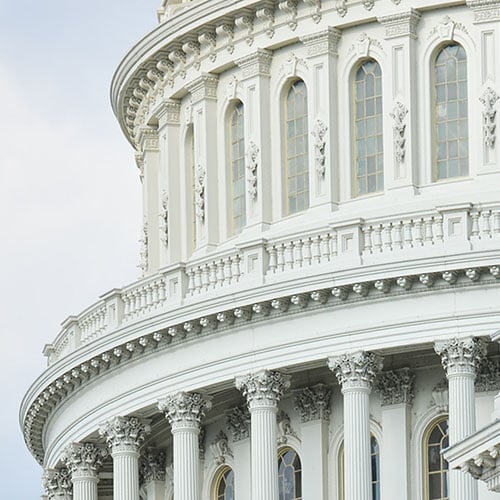.jpg?h=1150&iar=0&w=2560)
24 July 2024 • 5 minute read
US Supreme Court round-up: Business impacts for in-house counsel to know
During its 2023–2024 term, the US Supreme Court issued a number of rulings with major implications for businesses, especially those in regulated industries.
The Court’s decision in Loper Bright Enterprises v. Raimondo, decisively overruling the Chevron deference doctrine, stood out, grabbing headlines and warranting careful examination. But Loper Bright was not the Court’s only important regulatory ruling this term. Indeed, it was one of several decisions that, taken together, promise to reshape the regulatory landscape and invite challenges to federal agency actions. Plus, rulings on a range of other issues – from arbitration to whistleblower retaliation claims – warrant the attention of in-house counsel.
DLA Piper attorneys have been tracking these legal developments and their potential implications throughout the Supreme Court’s momentous term. Below we summarize some of the Court’s key business decisions and preview what’s ahead.
2023-24 term
Reshaping the administrative state

The end of Chevron deference
In Loper Bright Enterprises v. Raimondo, the Supreme Court overruled the Chevron deference doctrine, an administrative law precedent that provided the framework for judicial review of federal agencies’ formal interpretations of statutes for the past 40 years. This blockbuster ruling makes clear that courts can no longer defer to a federal agency’s views simply because the underlying statute does not clearly address the issue at hand and the agency’s interpretation seems reasonable. Rather, courts must employ the traditional tools of statutory construction to independently determine the “best reading” of the statute. For many regulated entities, the ruling will clear the way to successfully challenging federal regulations or agency adjudications. More broadly, it may carry important consequences for how agencies and Congress approach their respective regulatory roles.
Read our insights on Loper Bright’s impact, including implications for tax law, environmental regulation, and the life sciences.

Opening the door to new agency challengers

Limits on the use of agency’s administrative courts

What’s next for the CFPB?

The future of challenges to FDA decision-making
Employment

Easing the path for discriminatory transfer claims

FAA’s transportation worker exception not limited to transportation industry

National Labor Relations Board reeled in

Worker-friendly standard for whistleblower retaliation claims
We previously wrote about the circuit split and predicted Supreme Court review here.
Other key decisions

Snyder v. United States – What is the impact of the Supreme Court’s decision?

Federal courts must stay cases compelled to arbitration

Limiting chapter 11 as tool for collective resolution of mass tort liabilities

Pure omissions not misleading under Rule 10b-5b
What's ahead
What’s ahead
As of July 22, 2024 , the Supreme Court has agreed to hear more than two dozen cases during its October 2024 term. Below we highlight several upcoming cases, which promise to have important implications for businesses.
Securities fraud
The Court will consider two appeals that could have far-reaching implications for pleading requirements in securities fraud class actions.
In NVIDIA Corp. v. E. Ohman J:or Fonder AB, the Court has agreed to consider the heightened pleading standards for scienter and falsity in securities fraud claims under the Private Securities Litigation Reform Act (PSLRA). The petition presents two questions: (1) whether securities fraud plaintiffs attempting to plead a “strong inference” of scienter based on allegedly contrary internal reports must plead details about the contents of those reports, and (2) whether falsity can be adequately alleged based on an expert’s after-the-fact opinion instead of pleading contrary, contemporaneous facts.
In Facebook, Inc. v. Amalgamated Bank, a case arising from the alleged misuse of Facebook user data by Cambridge Analytica, the Court has been asked to clarify whether “risk factor” disclosures provided by a public company in its periodic reports can be the basis for claims of securities fraud if they do not disclose the previous materialization of an identified risk, even if that previous instance did not result in any known threat of business harm.
Employment
The Supreme Court is set to address several employment and benefits issues.
In E.M.D. Sales, Inc. v. Carrera, the Supreme Court is expected to resolve a longstanding circuit split: What burden of proof must employers satisfy to demonstrate the applicability of a Fair Labor Standards Act (FLSA) exemption? While six circuits have held that employees must show that employees are exempt from the FLSA by only a preponderance of the evidence, the US Court of Appeals for the Fourth Circuit has long imposed a clear and convincing standard.
In Stanley v. City of Sanford, Florida, the Supreme Court will address whether former employees may bring discrimination suits under the Americans with Disabilities Act (ADA) related to the distribution of post-employment benefits. Here, too, the Court’s ruling should resolve a longstanding circuit split – this one concerning the scope and significance of the definition of a “qualified individual” under the ADA.
Environmental regulation
In the coming term, the Supreme Court will decide several issues related to environmental protection and regulatory clarity.
Seven County Infrastructure v. Eagle County, Colorado concerns the scope of federal agency review under the National Environmental Policy Act (NEPA), which requires agencies to evaluate the environmental impacts of proposed government actions and to inform the public of those assessments and corresponding decisions. The Supreme Court will consider whether NEPA requires an agency to study environmental impacts beyond the proximate effects of the action over which the agency holds regulatory authority, and is expected to resolve a circuit split over the breadth of the environmental assessments statutorily required.
In City and County of San Francisco v. Environmental Protection Agency, the Court agreed to consider whether the Clean Water Act authorizes the Environmental Protection Agency (or authorized state regulators) to include general prohibitions in wastewater discharge permits (known as National Pollutant Discharge Elimination System or NPDES permits) that subject permitholders to enforcement for violating water quality standards but do not specify the limits with which their discharges must conform. The Court will seek to resolve whether permitholders must be on notice of how much they must control their discharges, or whether a general prohibition against too much pollution suffices.
The outcomes of these cases could have significant implications for regulatory decision-making and environmental assessments.
Civil procedure and civil remedies
In Royal Canin U.S.A. Inc. v. Wullschleger, the Court is set to address key procedural questions: If a complaint is amended after the case is removed to federal district court and the basis for federal question jurisdiction is removed, does the district court still have a basis for subject matter jurisdiction? Can the court still exercise supplemental jurisdiction over the plaintiff’s remaining state-law claims pursuant to 28 U.S.C. § 1367?
Other cases will have the Supreme Court examine the standard that must be met to qualify as a prevailing party for purposes of attorney’s fees under 42 U.S.C. § 1988 and consider whether an award of “the defendant’s profits” under the Lanham Act may require the defendant to disgorge the profits of non-party corporate affiliates.
We will continue monitoring these cases and more in the coming year. In the meantime, please contact the authors of the alerts linked above or with your DLA Piper contacts if you have questions about how the Supreme Court’s decisions this term or next term may impact your business and workforce.


